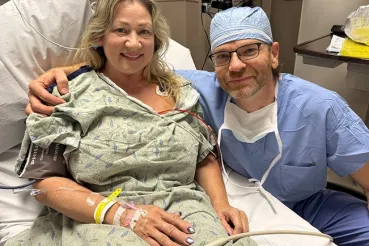Your shoulders shoulder a heavy load (pardon the pun). They are among the body's most complex and mobile joints, enabling us to push, pull, lift and carry — movements we use every day in countless ways, both routine and extraordinary.
But their very complexity and range of motion also make shoulders highly vulnerable to injury, according to Grant Garrigues, MD, a sports medicine surgeon at Rush University Medical Center who specializes in diagnosing and treating shoulder issues.
Causes of rotator cuff tears
In the most basic terms, the shoulder is a ball (top of the arm bone) and socket (shoulder blade) joint. The most common shoulder injuries involve the group of muscles and tendons that surround the ball and both give it stability and mobility: the rotator cuff.
These are the primary causes of rotator cuff tears:
- Overuse, which can lead to tendonitis or irritation. "This is quite common," Garrigues says. "You see it a lot in people who play overhead sports, like tennis, baseball, softball and volleyball, or those who lift heavy weights overhead. But it can also happen if you're doing a strenuous activity where your arms are up over your head for long periods of time — a demanding home improvement project, for example.”
- Trauma. From the major to the minor — a car wreck to lifting something awkwardly — trauma can cause or intensify rotator cuff tears.
- Degeneration. "Age is the number one risk factor for rotator cuff tears," Garrigues says. In fact, a study published in the Journal of Orthopaedic Surgery found that people age 60 and older are more than five times as likely to suffer a rotator cuff tear than people younger than 60. That number increases with age, and is even higher in smokers and those with other health problems like high cholesterol, diabetes or rheumatoid arthritis.
Preventing rotator cuff tears
You can't keep yourself from aging, but there are steps you can take to keep your shoulders healthy and avoid rotator cuff tears.
1. Pay attention to your shoulder blades
The rotator cuff supports the ball and socket, but your shoulder blades support the entire shoulder. "The shoulder sits on the mobile platform of the shoulder blade," Garrigues explains. "So to fully support the rotator cuff, it's essential to have healthy shoulder blades."
That means focusing on both posture and strength.
Posture
To correctly position your shoulder blades, pull them back and down. "Too often we spend our days bent over a device or keyboard, so we can all stand to work on our posture. Get in the habit of pulling those shoulder blades back and down whenever you feel yourself hunching over," Garrigues says.
Strength
Even if you have a lot of upper body muscle, if your shoulder blade muscles are not strong it will affect your posture and potentially irritate your rotator cuff. And unfortunately, it's easy to overlook the smaller muscles that control the position of the shoulder blades — including the rhomboids, serratus anterior and lower trapezius.
"You would be hard pressed to find even the most dedicated gym rat who says, 'I'm going to go to the gym and work on my rhomboids today.' " Garrigues says. "Even with the trapezius it's always the upper traps that people focus on."
There are some simple exercises you can do either at the gym or at home to strengthen these essential postural muscles:
- Low row using rowing machine or cables. Focus on proper form — pinching shoulder blades together and bringing the bar into the bottom of your ribcage, so you’re working on the muscles that hold the shoulder blade back and down.
- External rotation using bands or cables. While standing, place your arms at your side. Start with one arm, raising the forearm until it's at a 90 degree angle from your upper arm (making an "L" shape). Keeping your elbow at your side, rotate your hand away from your body. The key is to emphasize muscle endurance, so use a light weight and do 20-30 repetitions on each side.
2. Steer clear of nicotine
We all know that smoking and smokeless tobacco are bad for your health. But did you know that other than aging, smoking is the single biggest risk factor for rotator cuff tears?
Just as significant, if you have surgery to repair a torn rotator cuff, smoking doubles the risk that the repair won't heal properly regardless of how small the tear is. So smoking not only causes the problem, it also makes the problem much harder to solve.
"Although most of the emphasis related to smoking is on things like birth defects, lung cancer, stroke and heart attacks, the orthopedic issues that smoking causes are real, and they're well documented," Garrigues explains. "When I see young patients with rotator cuff tears and they're smokers, they aren't making the connection. They just assume the injury is bad luck. Actually, it may be a wake-up call that they're already experiencing the negative effects of their unhealthy habit."
The culprit appears to be one specific ingredient in cigarettes: nicotine. "Nicotine gum, patches and vaping may be marginally better for your health than smoking or using smokeless tobacco, but if you're using them you'll still have an increased risk of rotator cuff tears," Garrigues says. "So it's best to avoid nicotine altogether."
Other than aging, smoking is the single biggest risk factor for rotator cuff tears.
3. Keep your cholesterol in check
"We don't know exactly why, but research has shown that in people with high cholesterol, there is a higher instance of rotator cuff tears," Garrigues says.
One study reported that more than 63 percent of participants with rotator cuff injury had elevated total cholesterol (above 240 mg/dl), and that triglycerides and LDL cholesterol were also significantly higher in the rotator cuff injury group than the non-injury group. Another found that patients with rotator cuff tears are more likely to have higher cholesterol than patients with shoulder pain who don't have tears.
And just as nicotine contributes to poor surgical healing, research has shown that patients with higher cholesterol levels face a significantly greater risk for failure of arthroscopic rotator cuff surgery.
If you have high cholesterol, talk to your doctor about ways to lower it, including medications, exercise and diet modifications.
4. Ease into strenuous activities
Weekend warriors and do-it-yourselfers, take note: Don't overdo it.
"Where we see rotator cuff tears related to overuse, the problem isn't the repetitive motion per se; it's the people who don't do any strenuous, overhead physical activity for awhile and then ramp up their activity in a short period of time," Garrigues explains. "Suddenly, they are inspired: 'I'm going to paint my ceiling today,' or 'Sure, I can play three sets of tennis.' "
Keeping your shoulders strong year-round will help you be ready for those bursts of activity. And if you've been on the sidelines awhile, start any rigorous activity slowly and build up to full exertion. "You don't want to go from 0 to 60," Garrigues says. "I encourage everyone to be active at any age, but you need to give the muscles and tendons a chance to catch up to your motivations and desires."
When to see a shoulder specialist
Classic symptoms of a rotator cuff tear include the following:
- Pain on the outside of the shoulder that worsens when you reach out away from your body or engage in overhead activities.
- Achiness in that same spot at night. "Night pain is a very common complaint with rotator cuff tears," Garrigues says. "Patients will tell me, 'If I put the pillow just so, I'm maybe able to get a couple hours of sleep.' If shoulder discomfort is keeping you from getting to sleep or waking you up in the middle of the night, that's reason to seek help."
If you're experiencing frequent pain, don't ignore it — especially if it affects your quality of life. Many rotator cuff tears can be treated non-operatively, with physical therapy and/or injections. Left untreated, however, there's a good chance the tear will get bigger over time.
"As the saying goes, 'A stitch in time saves nine.' " Garrigues says. "The results of surgically repairing small tears are much better than the results of repairing massive tears. That's why we prefer to catch and treat them early."
If too much time passes, the tears can get so big that they can't be repaired at all. Either the tendon shrivels up and cannot stretch far enough to be reattached, or the muscle turns to fat and there isn't anything left to reattach.
And what you fear is a rotator cuff tear may, in fact, turn out to be something less serious. According to Garrigues, many other conditions can mimic a rotator cuff tear. The most common is shoulder bursitis — inflammation right above the rotator cuff.
"Bursitis can typically be treated without surgery, whereas a full thickness rotator cuff tear may best be treated with surgery," he says. "That's why it's important to see a shoulder specialist who can properly diagnose the problem and prescribe the optimal treatment."




